The Moto G (2015) Review
by Brandon Chester on August 19, 2015 8:00 AM EST- Posted in
- Smartphones
- Mobile
Battery Life
Battery life is obviously one of the most important aspects of any mobile device, whether it be a laptop, a tablet, a smartphone, or a wearable device. To examine battery life on mobile devices we run them through a number of tests. The first is a web browsing test run both on WiFi and on LTE, which is primarily a display bound test. The next test is BaseMark OS II, which stresses the CPU. After that is PCMark which attempts to simulate various real world workloads, and is a good indicator of real world battery life. Finally, we test using GFXBench 3.0 to see how long a device lasts and how well it performs with a constant GPU load.
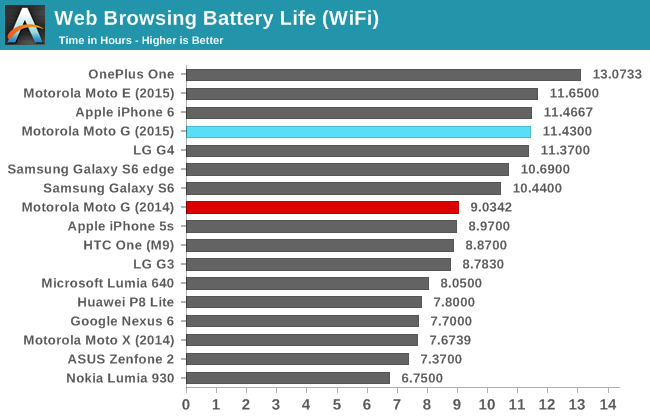
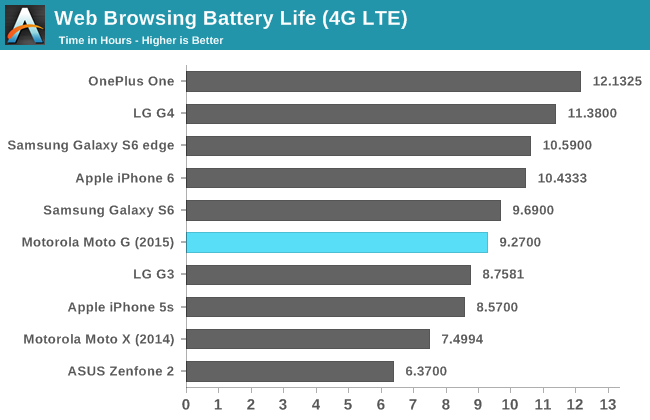
In both of our web browsing battery tests the Moto G performs very well. Through a combination of reduced platform power and a larger battery we see the 2015 Moto G last nearly 2.5 hours longer than its predecessor in the WiFi test. Unfortunately I don't have data for the 2014 model on LTE, but at 9.27 hours the Moto G's lifetime when browsing on cellular is also very respectable.
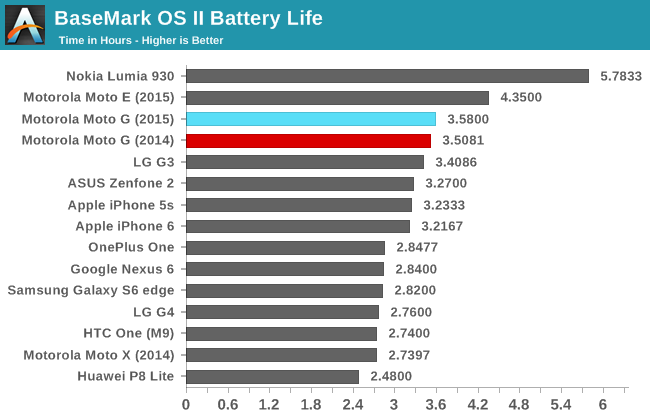
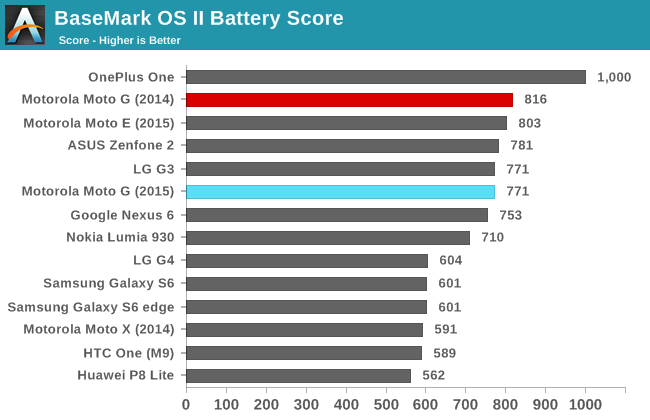
BaseMark OS II's battery test stresses the CPU a great deal, and in it we see the 2015 Moto G lasts roughly as long as its predecessor. Since the 2015 model has a significantly larger battery this implies a greater amount of battery drain in a given unit of time, which is what leads to the lower battery score for the 2015 model. If Snapdragon 410 were produced on a lower leakage process like 28nm HPm or HPC rather than 28nm LP we would see a significant improvement to power consumption in CPU heavy workloads.
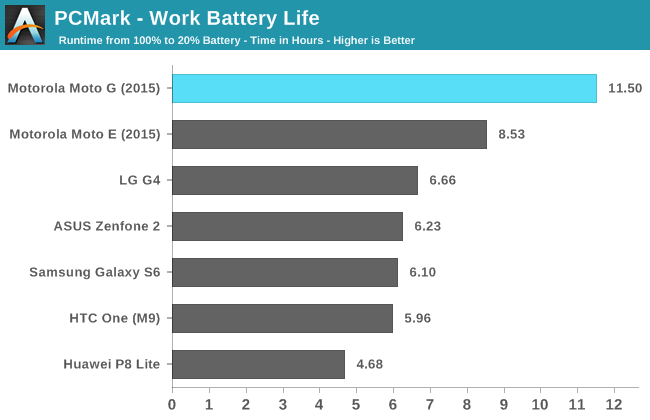
In PCMark's battery test the Moto G is in a league of its own. Due to its relatively large battery it pulls ahead of other mid range devices by a large margin. The downside of course is that if you were a user going through the workloads PCMark performs you would have substantially worse performance than a device like the Zenfone 2. I think the Moto G's runtime in PCMark demonstrates an important consideration for consumers, with a device like the Zenfone 2 being much faster than the Moto G at roughly the same price, but offering only a little more than half the battery life in a mixed workload. If battery life is your priority in a mid range device the 2015 Moto G appears to be the best option by far.
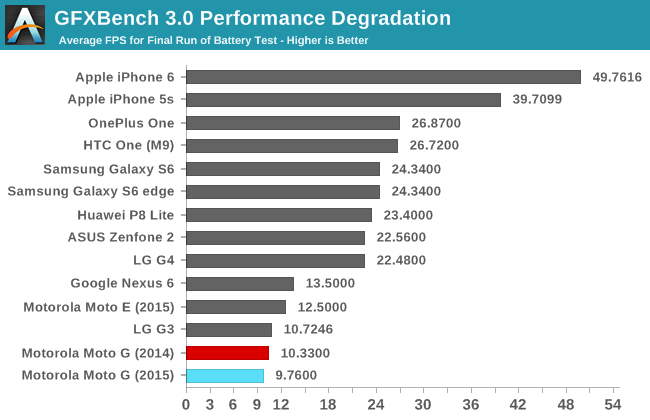
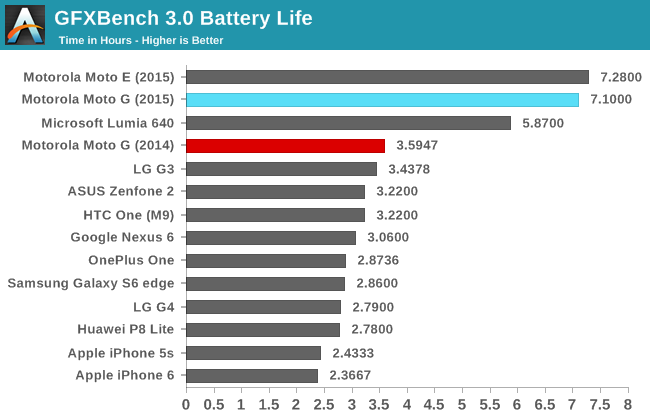
Low and and mid range devices with big batteries and relatively low GPU performance tend to do well in GFXBench's battery test. While they do last long, the performance during the T-Rex HD test that continually loops is well below what would be considered a playable frame rate, and so it's not really worth discussing in much detail.
Overall, I'm very happy with the new Moto G's battery life. Both the web browsing results and the PCMark result confirm my experience in the real world which is that the Moto G lasts for a really long time. I often found myself only charging it every other day unless I had been using it very heavily, and it's really one of the only devices I own where I didn't even bother to take a look at the battery percentage from time to time. The only disappointment is the knowledge that if Snapdragon 410 were produced on a lower leakage process we could see even higher performance with the same great battery life that the Moto G achieves.
Charge Time
While the Moto G has a fairly substantial battery life, it will eventually die and need to be recharged. We've seen a large improvement in the charge time of mobile devices with the adoption of fast chargers that supply as much as 18W of power to a device. Unfortunately, this hasn't trickled down to low end and mid range devices yet, and as a result they often suffer from very long charge times using their included chargers.

The combination of a 9.39Wh battery and a 2.75W charger leads to the longest charge time on record for a mobile device. While it's only a couple minutes longer than the Huawei P8 Lite, it's substantially longer than most other phones. Since the Moto G has very good battery life users can just charge their phone at night, which puts it in a better situation than the P8 Lite. Despite that, I wish Motorola had considered the additional charge time their larger battery would require and included a 5W charging block to compensate. If a user has a spare 5W or higher charging block or lives in a region where the Moto G comes with one they will see the charge time drop to as low as 2 hours and 50 minutes, which is much more reasonable.










90 Comments
View All Comments
3DoubleD - Wednesday, August 19, 2015 - link
Thanks for the response!1. The 5W charging time would be great! Thanks for adding that.
2. I agree, it is too bad they are hamstringing the GPUs in these devices. Three generations of Moto G including the same GPU is pretty disappointing. It seems Motorola is keeping customers interested in AAA gaming on their more expensive phones, which is understandable. From what you are saying, it sounds like the poor display calibration and poor visibility in sunlight would be more apparent to non-gamers than the GPU.
3. What I'm referring to is your comments in the concluding remarks: "The waterproofing is definitely a neat addition, but I think in most cases it's just a nice thing to have rather than a selling point. Once waterproofing is accompanied by the ability to use the display when it's really wet I'll be a lot more interested in it." I suspect many people will see waterproofing as a selling point (AKA a desirable feature) just from a pure ruggedness standpoint. Instances where people are deciding between several mid-range Android phones and pick the Moto G based on it being waterproof are probably more likely than decisions based on many of the other specs.
4. My problem with device thinness is that the benefit of thinner and thinner devices is dubious, yet the benefit for keeping the same thickness, or even increasing it, is substantial. I don't think a objective argument can be made for why a 6.9 mm phone is better than a 8 mm phone or even an 11.6 mm phone (like the Moto G). Even the subjective 'design' argument is pretty shaky, considering everyone was swooning over smartphone designs that first made it to 10 or 11 mm.
So as leading reviewer of phones and a spokesperson for the masses, I'd challenge you to develop a metric for phone thickness that equally considers 'thin design' with ease of use and battery life. IMO manufacturers hit the thin-enough-to-be-usable limit years ago. Let's stop praising thinness-at-all-costs in reviews (as is typical in a flagship Android or iPhone review) and start making a big deal when the design needlessly sacrifices battery life for thinness.
djc208 - Wednesday, August 19, 2015 - link
Seems to me the one major category that is missed between those two phones is support. More and more I'm just as interested in how it will be supported, and I wonder how well the Zenphone will be supported against future OS updates. I'd tend to lean toward Motorola for long term support. LG brought be in with great hardware but turned me off with crappy software support.Moto1 - Wednesday, August 19, 2015 - link
Zero support from Motorola. Emailed and called and all I get is generic replys-not related to my question. I bought the first moto g in anticipation of fast updates and have had zero-which sucks cause I was promised 5.0 over a year ago.Machete - Thursday, August 20, 2015 - link
False, we have a 1g Moto G in family and it was updated to 5.0 months ago.tipoo - Sunday, August 23, 2015 - link
Must be your carriers fault. My first gen G has been rocking 5 for months.tipoo - Wednesday, August 19, 2015 - link
MicroSD and 2GB RAM were the two things I sorely missed in my first gen G, so this looks like a fair upgrade. Honestly, it's all the phone most people need. Even the weak GPU runs most modern Android games well. The RAM was always the bigger issue than the processing speed, and the minor bump to the latter will be a nice bonus.Now just bring Moto Maker for the G to Canada and take my money, Motorola!
YukaKun - Wednesday, August 19, 2015 - link
So... Is this better than my SGS2? Y know the CPU is better, but is the camera and GPU?I'm having a considerable loss in battery life as of late (from 3 days to just 2) and the S2 is still running anything I need it to (GMail, GMaps and other "light" stuff) with no hiccups. So in my mind, instead of getting a battery replacement, maybe jumping to the MotoG 2015 might be a good idea.
Cheers!
a1exh - Wednesday, August 19, 2015 - link
Battery replacements are soooo cheap for the SGS2 though. If it is still going and you're happy. The SGS2 camera was better than the MotoG 2013a1exh - Wednesday, August 19, 2015 - link
As a MotoG 2013 customer I wanted the 2015 to be great. But it isn't. So the Vodafone Smart Ultra 6 is looking like the PAYG phone to get in the UK only it is a bit bigmkozakewich - Wednesday, August 19, 2015 - link
Devices like this really highlight the need for colour correction on Android. If it can fill the full sRGB gamut, the only thing left is to tell it where to put the colours. There's no reason something like this shouldn't be able to pull a dE2000 of 1.I remember the review of the Stream 7. Since it ran Windows, they were able to run a correction suite on it, and it ended up with a really good score despite its inability to saturate the blues.